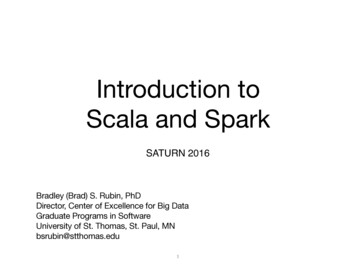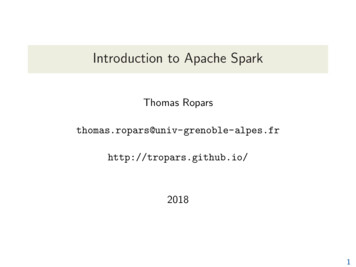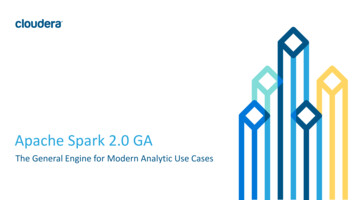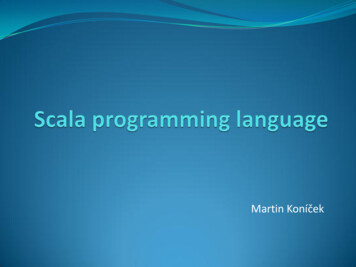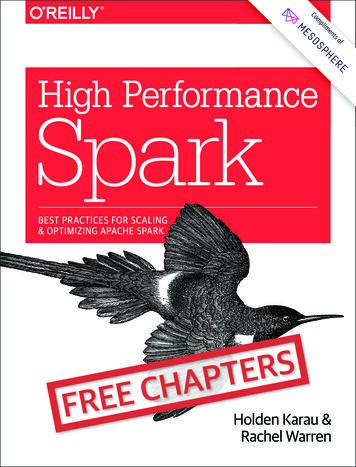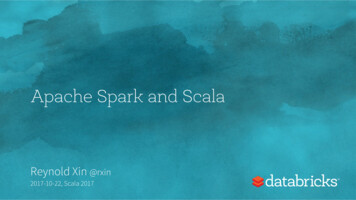
Transcription
Apache Spark and ScalaReynold Xin @rxin2017-10-22, Scala 2017
Apache SparkStarted in UC Berkeley 2010Most popular and de facto standard framework in big dataOne of the largest OSS projects written in Scala (but with user-facingAPIs in Scala, Java, Python, R, SQL)Many companies introduced to Scala due to Spark
whoamiDatabricks co-founder & Chief Architect- Designed most of the major things in “modern day” Spark- #1 contributor to Spark by commits and net lines deletedUC Berkeley PhD in databases (on leave since 2013)
My Scala / PL backgroundWorking with Scala day-to-day since 2010; previously mostly C, C ,Java, Python, Tcl Authored “Databricks Scala Style Guide”, i.e. Scala is a better Java.No PL background, i.e. from a PL perspective, I think mostly based onexperience and use cases, not first principle.
How do you compare this with X?Wasn’t this done in X in the 80s?
Today’s TalkSome archaeology- IMS, relational databases- MapReduce- data framesLast 7 years of Spark evolution (along with what Scala has enabled)
Databases
IBM IMS hierarchical database (1966)Image from /
“Future users of large data banks must be protected from having toknow how the data is organized in the machine. most application programs should remain unaffected when theinternal representation of data is changed and even when someaspects of the external representation are changed.”
Two important ideas in RDBMSPhysical Data Independence: The ability to change the physical datalayout without having to change the logical schema.Declarative Query Language: Programmer specifies “what” rather than“how”.
Why?Business applications outlive the environments they were created in:- New requirements might surface- Underlying hardware might change- Require physical layout changes (indexing, different storage medium, etc)Enabled tremendous amount of innovation:- Indexes, compression, column stores, etc
Relational Database Pros vs Cons- Declarative and data independent- SQL is the universal interface everybody knows- SQL is not a “real” PL- Difficult to compose & build complex applications- Lack of testing frameworks, IDEs- Too opinionated and inflexible- Require data modeling before putting any data in
Big Data, MapReduce,Hadoop
The Big Data ProblemSemi-/Un-structured data doesn’t fit well with databasesSingle machine can no longer process or even store all the data!Only solution is to distribute general storage & processing overclusters.
Google DatacenterHow do we program this thing?17
Data-Parallel ModelsRestrict the programming interface so that the system can do moreautomatically“Here’s an operation, run it on all of the data”- I don’t care where it runs (you schedule that)- In fact, feel free to run it twice on different nodes- Leverage key concepts in functional programming- Similar to “declarative programming” in databases
MapReduce Pros vs Cons Massively parallel Flexible programming model & schema-on-read Type-safe programming language (great for large eng projects)- Bad performance- Extremely verbose- Hard to compose, while most real apps require multiple MR steps- 21 MR steps - 21 mapper and reducer classes
R, Python, data frame
Data frames in R / PythonDeveloped by stats community & concise syntax for ad-hoc analysisProcedural (not declarative) head(filter(df, df waiting 50))## eruptions waiting##11.75047##21.75047##31.86748# an example in R
Traditional data frames Built-on “real” programming languages Easier to learn- No parallelism & doesn’t work well on med/big data- Lack sophisticated query optimization No compile-time type safety (great for data science, not so great fordata eng)
“Are you going to talkabout Spark at all!?”
Which one is better?Databases, R, MapReduce?Declarative, functional, procedural?
A slide from 2013
Spark’s initial focus: a better MapReduceLanguage-integrated API (RDD): similar to Scala’s collection libraryusing functional programming; incredibly powerful and composablelines spark.textFile(“hdfs://.”)points lines.map(line parsePoint(line))points.filter(p p.x 100).count()// RDD[String]// RDD[Point]Better performance: through a more general DAG abstraction, fasterscheduling, and in-memory caching (i.e. “100X faster than Hadoop”)
ProgrammabilityWordCount in 3 lines of SparkWordCount in 50 lines of Java MR
Why Scala (circa 2010)?JVM-based, integrates well with existing Hadoop stackConcise syntaxInteractive REPL
Challenge 1. Lack of StructureMost data is structured (JSON, CSV, Parquet, Avro, ) Defining case classes for every step is too verbose Programming RDDs inevitably ends up with a lot of tuples ( 1, 2, )Functional transformations not as intuitive to data scientists E.g. map, reduce
data.map(x (x.dept, (x.age, 1))).reduceByKey((v1, v2) ((v1. 1 v2. 1), (v1. 2 v2. 2))).map { case(k, v) (k, v. 1.toDouble / v. 2) }.collect()data.groupby(“dept”).avg()
Challenge 2. PerformanceClosures are black boxes to Spark, and can’t be optimizedOn data-heavy computation, small overheads add up Iterators Null checks Physical immutability, object allocationsPython/R (the data science languages) 10X slower than Scala
DemoRDD APIDataFrame API012345Runtime to count 1 billion elements (secs)67
Solution:Structured APIsDataFrames Spark SQL
DataFrames and Spark SQLEfficient library for structured data (data with a known schema) Two interfaces: SQL for analysts apps, DataFrames for programmersOptimized computation and storage, similar to RDBMSSIGMOD 2015
Execution StepsSQLDataFramesCodeLogical Optimizer PhysicalPlan GeneratorPlanDataSourceAPIRDDsCatalog
DataFrame APIDataFrames hold rows with a known schema and offer relationaloperations on them through a DSLval users spark.sql(“select * from users”)val massUsers users('country “Canada”)massUsers.count()Expression ASTmassUsers.groupBy(“name”).avg(“age”)
Spark RDD ExecutionJava/ScalafrontendJVMbackendopaque closures(user-defined functions)PythonfrontendPythonbackend
Spark DataFrame ExecutionPythonDFJava/ScalaDFLogical PlanCatalystoptimizerPhysicalexecutionRDFSimple wrappers to create logical planIntermediate representation for computation
Structured API Exampleevents sc.read.json(“/logs”)stats .avg(“duration”)errors stats.where(stats.status “ERR”)DataFrame APISCAN logsSCAN usersFILTERJOINAGGOptimized Planwhile(logs.hasNext) {e logs.nextif(e.status “ERR”) {u users.get(e.uid)key (u.loc, e.status)sum(key) e.durationcount(key) 1}}.Generated Code** Thomas Neumann. Efficiently Compiling Efficient Query Plans for Modern Hardware. VLDB 2011.
What has Scala enabled?Spark becomes effectively a compiler.Pattern matching, case classes, tree manipulation invaluable.Much more difficult to express the compiler part in Java.
Type-safety strikes backDataFrames are runtime type checked; harder to ensure correctnessfor large data engineering pipelines.Lack the ability to reuse existing classes and functions.
Datasets
Dataset APIRuns on the same optimizer and execution engine as DataFrames“Encoder” (context bounds) describes the structure of user-definedclasses to Spark, and code-gens serializer.
What are Spark’s structured APIs?Multi-faceted APIs for different big data use cases:- SQL: “lingua franca” of data analysis- R / Python: data science- Scala Dataset API: type safety for data engineeringInternals that achieve this:- declarativity & data independence from databases – easy to optimize- flexibility & parallelism from MapReduce – massively scalable & flexible
Future possibilities from decoupled frontend/backendSpark as a fast, multi-core data collection library- Spark running on my laptop is already much faster than PandasSpark as a performant streaming engineSpark as a GPU/vectorized engineAll using the same API
No language is perfect, but thingsI wished were designed differently in Scala(I realize most of them have trade-offs that are difficult to make)
Binary CompatibilityScala’s own binary compatibility (2.9 - 2.10 - 2.11 - 2.12 )- Huge maintenance cost for PaaS provider (Databricks)Case classes- Incredibly powerful for internal use, but virtually impossible to guaranteeforward compatibility (i.e. add a field)Traits with default implementations
Java APIsSpark defines one API usable for both Scala and Java- Everything needs to be defined twice (APIs, tests)- Have to use weird return types, e.g. array- Docs don’t work for Java- Kotlin’s idea to reuse Java collection library can simplify this (although itmight come with other hassles)
Exception HandlingOften use lots of Java libraries, especially for disk I/O, networkNo good way to ensure exceptions are handled correctly:- Create Scala shims for all libraries to turn return types into Try’s- Write low level I/O code in Java and rely on checked exceptions
Tooling so project can be more opinionatedNeed to restrict and enforce consistency- Otherwise impossible to train 1000 OSS contributors (or even 100 employees) on all language features properlyLack of great tooling to enforce standards or disable features
RecapLatest Spark take the best ideas out of earlier systems- data frame from R as the “interface” – easy to learn- declarativity & data independence from databases -- easy to optimize &future-proof- parallelism from functional programming -- massively scalable & flexibleScala’s a critical part of all of these!
Thank you & we are hiring!@rxin
Apache Spark Started in UC Berkeley 2010 Most popular and de facto standard framework in big data One of the largest OSS projects written in Scala (but with user-facing APIs in Scala, Java, Python, R, SQL) Many co
